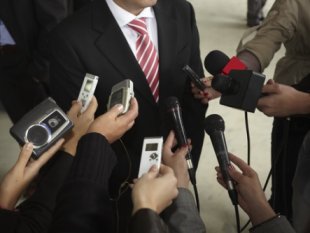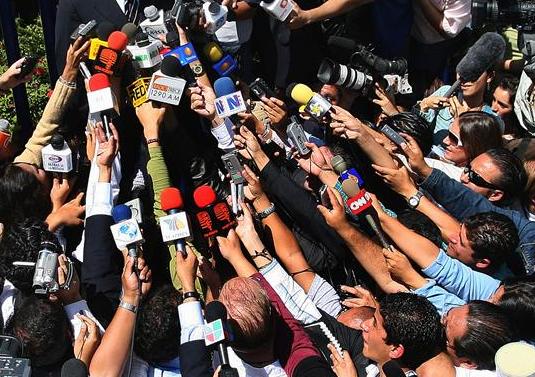When you’re the news: Top 10 tips for talking with media
July 23, 2014
Most of the time, you want it to happen. You’ve published a new book or article, the Chapman Media Relations Office is pitching it out, the media is picking up on it — and you start getting calls to be interviewed in print or by broadcast outlets. Or you’re an established authority in your field, and you get called by reporters for expert quotes.
And sometimes, you don’t really want it to happen, but you wind up being the focus of news, with the university encouraging you to talk with the press and get your side of the story out.
Here are ten tips for dealing with the media when you’re the focus of the news. Believe it or not, following these steps can make things a lot easier for both you (if you’re nervous, if you’ve never done this before, etc.) and the reporter (who just wants to get his or her story written, and deal with it as fairly as possible).
Whether the reporter is ringing you up for a quote or two, or talking with you at more length, here are some helpful do’s and don’ts.
1. Don’t be too verbose.
Many people will, in their nervousness, talk too much to a reporter, speak in long run-on sentences, and try to fill in any silences with yet more words. If you have a chance, take some time to practice before the interview. Work with someone in the PR office, who’ll be happy to take you through a practice interview. Also remember that it’s challenging for a reporter to edit a long string of comments into a sentence or two, which may be all they need. Your best chance at controlling which quotes they’ll use is not to give them a lot of choices. Be brief, pithy and to-the-point — talk in “sound bytes.”
2. DO think about what the READERS need.
Reporters are generally looking for “news our readers can use.” If you’re writing about a very complicated topic, say, in science or technology, they may only be interested in one very specific area of it that readers can relate to in their daily lives. Be patient with this — remember, they’re writing for the general public. It may all be a little fluffy, but it will also help get your name and your expertise out there in the media and encourage more reporters to come to you in the future. Keep in mind that they’re really looking for
how you can help their readers with your experience and ideas
.
3. Don’t be neutral.
Take a stand on one side or another. This is especially difficult for faculty in some fields, such as science – you naturally want to give a shout-out to “all sides” of an issue. Resist the urge. The more strongly opinionated you are, and the more unafraid you are to say it, the more likely you are to be quoted and featured.
4. Never say “no comment.”
This is pretty much a cardinal rule in media relations. Sure, you hear it on TV all the time, as the TV cop or lawyer dismissively body-slams through a mass of reporters. In real life, it’s not a wise phrase to use. It makes you sound arrogant…and worse, like you’re hiding something. A skeptical journalist sees “no comment” as a huge red flag that tells him or her to keep digging. What to say instead? If you truly have no answer or don’t know enough to be able to answer, it’s perfectly OK to tell a journalist, “I need to research that a little — may I have some time and call you with more? When is your deadline?”
5. Never ask “May I see a copy of your article before it’s published?”
Media outlets, as a rule, don’t allow this. On RARE occasions, as a courtesy, some may allow you to see your quotes in an article before it goes to print, or the reporter (or a fact-checker for the publication) may call you to verify some details. Count yourself lucky if this happens! But don’t ask.
6. DO give numbers and statistics.
Reporters and editors
love
numbers. They support and add credibility to your story, and editors can break them out and put them in little boxes or graphics (which they also love). So if you can work in numbers or stats to support your position, by all means do it!
7. DO ask “Do you need any other sources?” if you have some.
Providing the reporter with other sources or experts builds your credibility. Although, of course, we’d prefer them to be Chapman sources, they need not be — even sending them to outside sources tells them you’re willing to be helpful and that you’re concerned with making it a great and balanced story. It’s all part of relationship-building, and it’s a huge factor in getting that reporter — or his or her editor — to remember you as being helpful, and to come back to you in the future.
8. DO give reporters your contact information, even if they don’t ask.
In case they have follow-up questions, this makes it easier on them. And, again, you want to build that relationship and have them come back to you in the future.
9. DO be able to provide high-resolution images if needed.
The Media Relations office often can help you with this. As news outlets shrink and photographers are ever-busier, sometimes the reporter or editor won’t be able to send a photographer. Instead, they may ask you to send them a “mug shot” (portrait) of yourself, or even a photo or video of yourself in action in the classroom or out in the field. What they need are
not
images copied from the university’s or your own website (which are mostly low-resolution, 72 dots per inch). For print or to show on television, they need high-resolution digital images, at 300 dots per inch or more. For television, they may ask you for “B-roll” (pre-shot video footage made for media distribution). If you’re unsure of what this all means, call the Media Relations office and we’ll be happy to assist you. We have files of high-res imagery, or can assist you in setting up a photo shoot — and Panther Productions can sometimes assist with video.
10. DO say “thank you.”
Very shortly after the interview (the same day), send the reporter an email thanking them for a good chat (or, if it was a difficult subject, for their fairness in allowing you to tell your side). Send a few follow-up thoughts if any have occurred to you. Include web links or your own website link if applicable, but don’t be too verbose — keep it to a short paragraph or two. And as soon as the story appears online, drop the reporter another thank-you email, and then visit the online story and comment on it. If it’s a positive story and you’re really happy with it, don’t waste any time in linking to it from your own website or Facebook page, tweeting out the link or using other social media to spread the story around. Reporters and editors are people, too – they like to know their work is appreciated.
Want assistance? Have questions about dealing with the media? Call Chapman’s Communications and Media Relations Office, 714-628-7271, and we’ll be happy to help.

